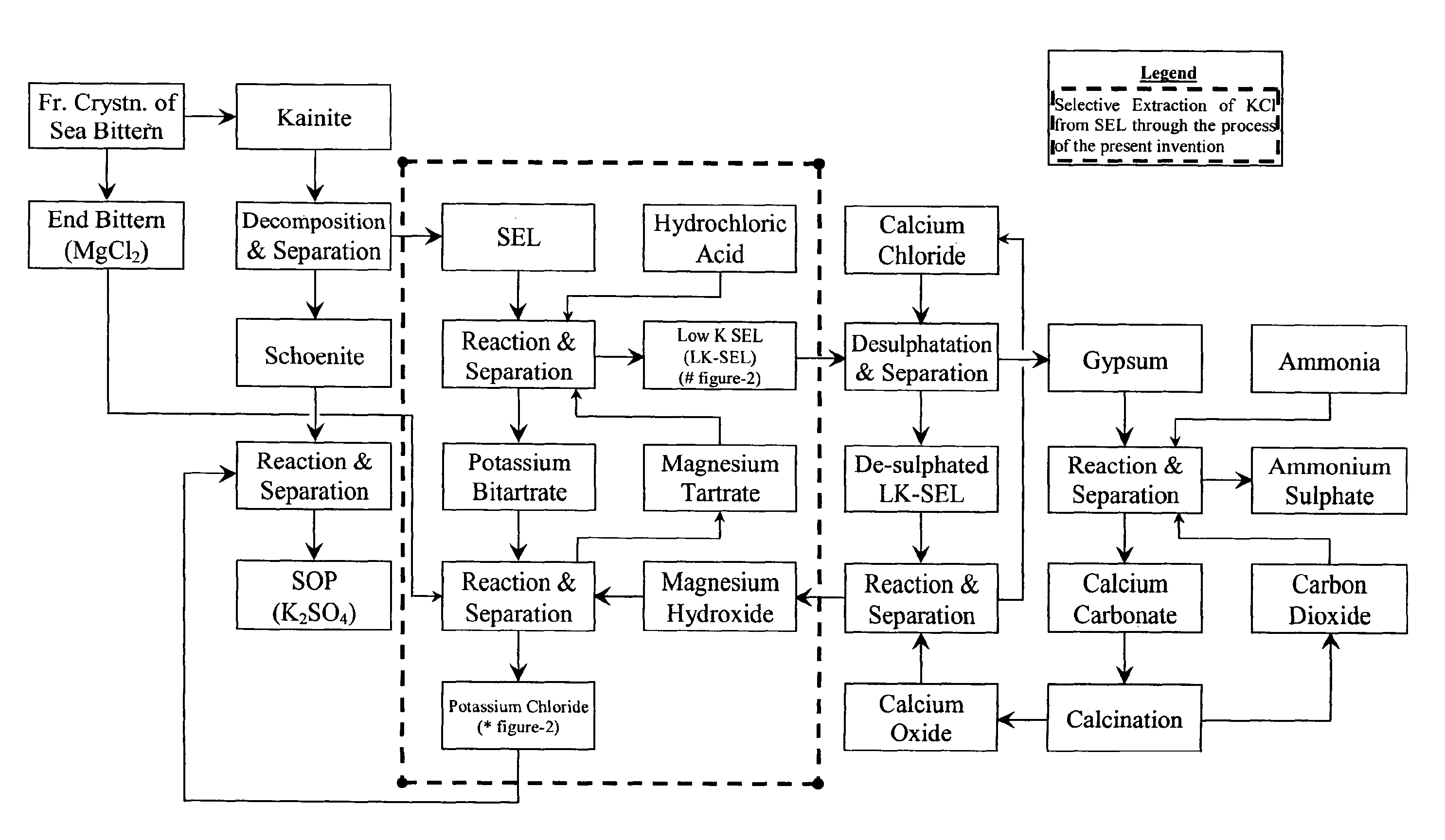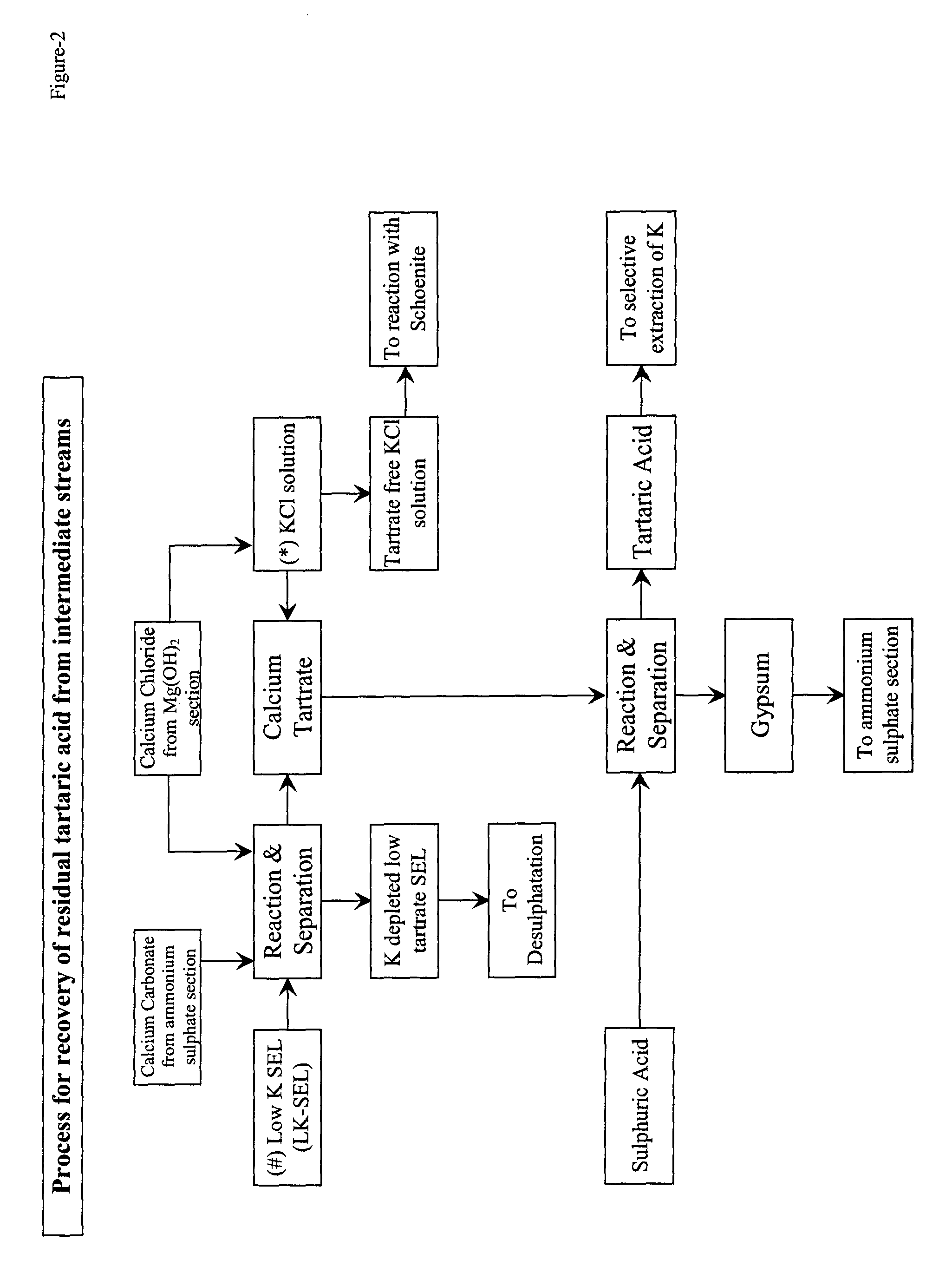Selective extraction of potassium chloride employing tartaric acid as safe, benign and recyclable extractant
a technology of tartaric acid and extractant, which is applied in the direction of alkali metal chlorides, etc., can solve the problems of commercial implementation of the process, serious operational & environmental problems, and patents that do not teach us about extractant recycling
- Summary
- Abstract
- Description
- Claims
- Application Information
AI Technical Summary
Benefits of technology
Problems solved by technology
Method used
Image
Examples
example 1
[0081]1 L of SEL [K: 4.83% w / v (1.24 mol), Na: 5.7% w / v (2.48 mol)] was reacted with 167.12 gm (1.11 mol) DL-tartaric acid and 32.5 gm of magnesium hydroxide (0.56 mol) under stirring for 22 hrs at 25±1C. The final pH was 1.30. Upon filtration of the resultant slurry, 810 mL filtrate [K=0.20% w / v (0.04 mol)] and a wet solid was obtained, which was washed with 100 mL water & dried to obtain 291 gm of product with 15.46% K and 0.59% Na content.
example 2
[0082]The experiment of Example 1 was repeated except that DL-tartaric acid was replaced with L-tartaric acid. The final pH was 1.26. 910 mL filtrate [K=0.22% w / v (0.05 mol), tartaric acid=2.38% (w / v) (0.14 mol)] and 193 gm of solid containing 22% K and 0.24% Na was obtained. The K content matched reasonably with the expected value of 20.74% K for potassium bitartrate.
[0083]Examples 1 and 2 above teach us the method of precipitation of potassium from SEL, as potassium bitartrate, with lower retention of mother liquor, using the combination of L-tartaric acid and Mg(OH)2. The data of Example 2 further indicate that residual tartrate in the filtrate is only 12% of the amount taken even when the reaction is conducted at room temperature (25±1C). Further, the observed weight (193 g) of potassium bitartrate matches well with the 88% recovery for which the computed yield is 184 g. This data in combination with the data on K percentage indicate satisfactory purity of the product, the small...
example 3
[0084]500 mL bittern [K: 1.7% w / v (0.22 mol), Na: 3.4% w / v (0.74 mol)] was reacted with 29.42 gm (0.20 mol) of L-tartaric acid & 5.72 gm of magnesium hydroxide (0.10 mol) under stirring for 18 hrs at 25±1C. The final pH was 0.7. Upon filtration of the resultant slurry, 505 mL of filtrate [K=0.55% w / v (0.07 mol)]& wet solid was obtained which was further washed with 50 mL water & dried to produce potassium bitartrate [18.8 gm; K: 22.70% (0.11 mol)].
PUM
| Property | Measurement | Unit |
|---|---|---|
| temperature | aaaaa | aaaaa |
| weight | aaaaa | aaaaa |
| molar ratio | aaaaa | aaaaa |
Abstract
Description
Claims
Application Information
 Login to View More
Login to View More - R&D
- Intellectual Property
- Life Sciences
- Materials
- Tech Scout
- Unparalleled Data Quality
- Higher Quality Content
- 60% Fewer Hallucinations
Browse by: Latest US Patents, China's latest patents, Technical Efficacy Thesaurus, Application Domain, Technology Topic, Popular Technical Reports.
© 2025 PatSnap. All rights reserved.Legal|Privacy policy|Modern Slavery Act Transparency Statement|Sitemap|About US| Contact US: help@patsnap.com



